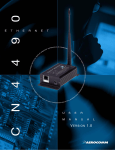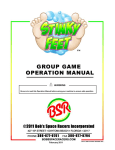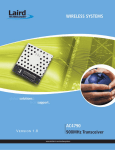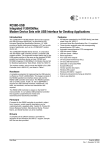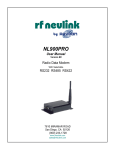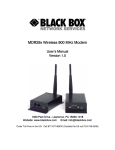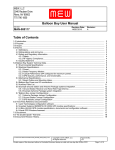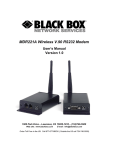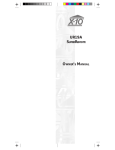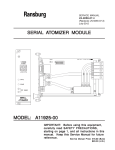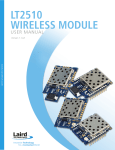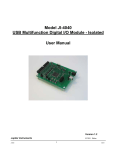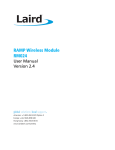Download MDR220A-R2 user`s manual.book
Transcript
MDR220A-R2 Wireless 900 MHz Modem User’s Manual Version 1.0 1000 Park Drive - Lawrence, PA 15055-1018 Website: www.blackbox.com Email: [email protected] Order Toll Free in the US: Call 877-877-BBOX (Outside the US call 724-746-5500) Technical Support: Phone: 877.877.BBOX Outside US: 724.746.5500 Web: www.Black Box.com Document Information Copyright © 2008 Black Box, Inc. All rights reserved. The information contained in this manual and the accompanying software programs are copyrighted and all rights are reserved by Black Box, Inc. Black Box, Inc. reserves the right to make periodic modifications of this product without obligation to notify any person or entity of such revision. Copying, duplicating, selling, or otherwise distributing any part of this product or accompanying documentation/software without the prior consent of an authorized representative of Black Box, Inc. is strictly prohibited. All brands and product names in this publication are registered trademarks or trademarks of their respective holders. This material is preliminary Information furnished by Black Box in this specification is believed to be accurate. Devices sold by Black Box are covered by the warranty and patent indemnification provisions appearing in its Terms of Sale only. Black Box makes no warranty, express, statutory, and implied or by description, regarding the information set forth herein. Black Box reserves the right to change specifications at any time and without notice. Black Box’s products are intended for use in normal commercial and industrial applications. Applications requiring unusual environmental requirements such as military, medical life-support or life-sustaining equipment are specifically not recommended without additional testing for such application. Limited Warranty, Disclaimer, Limitation of Liability For a period of one (1) year from the date of purchase by the OEM customer, Black Box warrants the OEM transceiver against defects in materials and workmanship. Black Box will not honor this warranty (and this warranty will be automatically void) if there has been any (1) tampering, signs of tampering; 2) repair or attempt to repair by anyone other than an Black Box authorized technician. This warranty does not cover and Black Box will not be liable for, any damage or failure caused by misuse, abuse, acts of God, accidents, electrical irregularity, or other causes beyond Black Box’s control, or claim by other than the original purchaser. In no event shall Black Box be responsible or liable for any damages arising: From the use of product; From the loss of use, revenue or profit of the product; or As a result of any event, circumstance, action, or abuse beyond the control of Black Box, whether such damages be direct, indirect, consequential, special or otherwise and whether such damages are incurred by the person to whom this warranty extends or third party. If, after inspection, Black Box determines that there is a defect, Black Box will repair or replace the OEM transceiver at their discretion. If the product is replaced, it may be a new or refurbished product. Revision History Revision Description Version 1.0 1/3/08 - Initial Release Version C o n te n ts MDR220A-R2 RF Transceiver 1 Overview 1 Specifications 2 Hardware Interface 3 Configuration Utility 4 Overview 4 Software Installation 4 PC Settings Page 5 Port1/Port2 Options 6 Other Options 6 Status Bar 7 About Button 7 Configure Page 8 Read Radio Button 8 Write Radio Button 9 Show Defaults Button 9 Pairing Button 9 Load / Save to File Buttons 9 Port 1/Port 2 Buttons 10 Hex/Decimal Button 10 Terminal/Chat Page 11 Send Button 11 Hexadecimal / ASCII Display 11 Range Test Page 12 Test Selection 12 Transmit Packet Selection 13 Test Type 13 Receive Packet Display 13 Device Setup 14 Windows Modem Setup & Configuration 14 Auto-answer Feature 19 Enable Auto-Answer on the MDR220A-R2 20 Enable DTR On 20 Save the Auto-Answer configuration to a modem Profile, 0 or 1. 20 Recall Profile Settings 20 Connecting to a Non-PC Device 20 Troubleshooting 20 MDR220A-R2 RF T RANSCEIVER 1 Black Box’s new MDR220A-R2 RF transceiver is a Frequency-Hopping Spread Spectrum (FHSS) radio designed for license free operation in the 900 MHz ISM band. Requiring no additional FCC licensing in the Americas, OEMs can easily make existing systems wireless with little or no RF expertise. The MDR220A-R2 and MDR221A-R2 products provide a wireless point-to-point connection between an RS232 device and a 56k data/fax modem. OVERVIEW This document contains information about the hardware and software interface between a MDR220A-R2 transceiver and an OEM Host. Information includes the theory of operation, specifications, interface definitions, configuration information and mechanical drawings. Note: Unless mentioned specifically by name, the MDR220A-R2 will be referred to as "radio" or "transceiver". Individual naming is used to differentiate product specific features. The host (PC/Microcontroller/Any device to which the MDR220A-R2 is connected) will be referred to as "OEM Host" or “Host.” 2 S PECIFICATIONS Table 1: ConnexNet Specifications General Interface Connector Dual RJ-11 jack RF Connector RPSMA (Reverse polarity SMA) jack Impedance 50 ohms unbalanced Channels 32 (USA/Canada), 7 (Australia) Security One byte System ID. 56-bit DES encryption key. Interface Buffer Size Input/Output: 256 bytes Transceiver Frequency Band 902 - 928 MHz (USA/Canada); 915 - 928 MHz (Australia) RF Data Rate (Raw) 76.8 kbps RF Technology Frequency Hopping Spread Spectrum (FHSS) Output Power EIRP (3dBi gain antenna) 1000 mW Supply Voltage 7 - 25 VDC Current Draw (mA) TBD Sensitivity -99dBm Range, Line of Site (based on 3dBi gain antenna) Up to 20 miles Environmental Temperature (Operating) -40°C to 85°C Physical Dimensions 4.4” x 2.7” x 1.4” Certifications FCC Part 15.247 KQLAC4490 Industry Canada (IC) 2268C-AC44901000 3 H ARDWARE I NTERFACE Table 2: Status LED descriptions Status LEDs RPSMA Antenna Connector Pwr Link Rx LED Color Description Power Green On indicates that the unit is powered up. Link Red On indicates that the Client unit(s) and Server unit are in Range of each other. Client unit activates the Link LED when in range of the Server unit. Always lit on a Server unit. RXD Green When flashing, indicates that the device is receiving data. TXD Red When flashing, indicates that the device is transmitting data. Tx C ONFIGURATION U TILITY 4 OVERVIEW Black Box provides an easy to use Configuration utility to program and test the device. The GUI based software is compatible with Microsoft® Windows 95, 98, 2000, ME, NT, & XP. SOFTWARE INSTALLATION Locate the OEM software folder on the Black Box Tools & Literature CD and install the development kit software. To install the software, run Setup.exe and follow the installation prompts. During the installation, the software will prompt the user to install the Black Box USB Driver. It is recommended that the user installs the driver at the same time as the software. Note: The USB driver is only required for Black Box devices with a USB interface and is not required by the MDR220AR2 transceiver. The installer will notify the user when the software has successfully been installed. The user may be prompted to reboot the PC to complete the installation. Click OK to complete the installation. By default, the software is stored in the following location on the Start Menu: Start -> All Programs -> Black Box Network Services -> Black Box Config CONFIGURATION UTILITY PC SETTINGS PAGE The PC Settings page is shown below, as it will appear the first time the program is run. The first time the software is run, it will prompt you to select a product. Select the correct product in the Product pulldown menu. Doing this will automatically select the default baud rate for that particular transceiver. If the COM port is listed as unavailable, a different COM port can be selected in the Port pull-down menu. The software can use two serial ports if the Enabled: box is checked. 5 6 CONFIGURATION UTILITY Port1/Port2 Options The software can control up to (2) COM ports or TCP/IP ports, including virtual COM ports, which physically map to USB or Ethernet ports. An error message will be displayed if a port is selected that is either nonexistent or already occupied by another software program. When a port selection is made, the software will attempt to open the port and list its status as; Unavailable, Open or Closed. Although menus are shown for Data Bits, Parity and Stop Bits, only the Parity menu selection can be changed. USB/COM PORT Select this if you are using a standard COM port or have setup the ConnexNet as a Virtual COM Port. TCP/IP PORT Select this is you are connecting to the ConnexNet using a TCP/IP socket (default configuration). Note: The port field must be set to 2101. FIND PORTS BUTTON If the available COM ports / IP addresses are unknown, the Find Ports button can be pressed to update the Port Selection pull-down menu with all available COM ports / IP addresses. HANDSHAKING By default the OEM utility will use hardware handshaking and monitor the CTS/RTS lines. For cases where these lines are not readily available such as RS-485 communications, the handshaking can be disabled by selecting “None” from the dropdown box. Note: Handshaking box does not appear when TCP/IP Port is selected. Other Options These are additional options that can be enabled. SAVE SETTINGS ON EXIT When enabled, all changes made to the Settings page will be automatically loaded the next time the software is run. Otherwise, the changes will be discarded. READ/WRITE WITH AT COMMANDS When enabled, the software will use AT Commands for its read/write EEPROM functions instead of the standard configuration commands. This box should be enabled at all times. AUTO BAUD When enabled, the software will scan all available COM Ports using the most common baud rates, until a radio is found. If no radio is found or the software cannot open the port, an error message will be reported. The software will only use Auto Baud when prompted by the user after an unsuccessful write process. To cancel the Auto Baud process, press the ESC key. Note: Auto Baud feature does not work when TCP/IP Port is selected. AUTO ARCHIVE EEPROM SETTINGS When enabled, the software will archive the EEPROM settings for each radio after a successful write process. Although not required, the software will prompt the user to type a description of the changes made. Auto Archive can be used to restore the radio to a previously known working configuration. The first time that a radio is read with Auto Archive enabled will be stored as the “Original Configuration Settings” with the date and time the record was created. MONITOR UDP FOR NEW DEVICES When enabled, the software will automatically listen for new ConnexNet devices using the UDP port and automatically add them to the Port Selection dropdown. CONFIGURATION UTILITY Status Bar Located at the bottom of the software, the status bar gives the state of Port 1, RTS Port 1, CTS Port 1, Port 2, RTS Port 2, and CTS Port 2 lines. When the text appears black, the current state will be shown. When the text appears gray, the current state will not be shown. The text shown in the bottom status bar gives a simplified status of the current, pending software process. The software has no pending process when “Communications Idle” is shown. About Button The About button can be pressed to determine the revision number of the software and the contact information for Black Box. Please include the software revision number in any correspondence with Technical Support. 7 8 CONFIGURATION UTILITY CONFIGURE PAGE The Configure page is a GUI representation of the 256 byte EEPROM contents within the radio. The same data is shown in a full hexadecimal dump of the EEPROM in the EEPROM Editor View. The Configure page is shown below, as it will appear until a radio is successfully read: There are five sections on the Configure page; Radio Interface, Radio RF, Radio Features, Radio Other, and Info Center. The fields displayed in these sections vary depending on the Product Mode. The Info Center provides a quick description of each setting/mode. For detailed decriptions of the individual settings, please refer to the OEM Module user’s manual. Read Radio Button To update the Configure and EEPROM Editor View pages with the EEPROM contents of a radio you are currently connected to, click the Read Radio button. An example of the Configure page after a transceiver has successfully been read is shown below: CONFIGURATION UTILITY Write Radio Button After making changes to the controls on the Configure page, the Write Radio button can be pressed to save those changes to the radio EEPROM. The user will be notified of a successful write with a “Write successful” prompt. If Auto Archive is enabled, the software will prompt the user to type a description of the changes made. Show Defaults Button When the Show Defualts button is pressed, the GUI view will be updated with the default settings for the selected product. This feature is only available on the GUI Page and will not work when using the EEPROM Editor View. Pairing Button The pairing button can be used to pair (address) two radios together. The two radios must both be connected to the PC and to the Ports specified on the PC Settings page. The pairing function sets one radio as a Server and the other as a Client and programs each radio’s Destination Address with the other radio’s MAC Address. Load / Save to File Buttons A file previously created by this software can be loaded to restore an EEPROM to a former state. Files of type *.TXT and *.EE can be loaded. 9 10 CONFIGURATION UTILITY An EEPROM can be saved to a file using the Save to File button. This allows for the current state of the EEPROM to be restored at a later time. Port 1/Port 2 Buttons When Port 1 is depressed, the Write Radio and Read Radio buttons communicate through Port 1. When Port 2 is depressed, the Write Radio and Read Radio buttons communicate through Port 2. Hex/Decimal Button All of the text entry type boxes found on the Configure page have a button located to the right of the box. When pressed a menu will be shown which allows the selection of either Hexadecimal or Decimal numbering format for that particular text box. CONFIGURATION UTILITY TERMINAL/CHAT PAGE The Terminal/Chat page is a terminal emulator (similar to HyperTerminal) used to send small data packets between two COM ports. As data is received it is appended to the appropriate Port window. An example of the Terminal/Chat page is shown below. Send Button This button sends the data in the textbox out the selected port(s). The current user’s Windows username is also sent over the RF with the data. Hexadecimal / ASCII Display New received data will be displayed in ASCII or Hexadecimal format; depending on the current setting. 11 12 CONFIGURATION UTILITY RANGE TEST PAGE The Range Test page allows packets of data to be sent between two radios and reports the numbers of successes and errors. Test Selection There are six test options that can be selected. There are three typical hardware setups. 1 One radio is plugged into a serial or USB port on a PC. The second radio is plugged into a separate power supply with a loopback adapter connected. 2 One radio is plugged into a serial or USB port on a PC. The other radio is plugged into a different serial or USB port on the same computer. 3 One radio is plugged into a serial or USB port on a PC. The other radio is connected to a serial or USB port on another PC. CONFIGURATION UTILITY If using two PCs for the test, the software run on both sides should have the second COM port disabled on the Settings page. Table 3: Test Selection Settings Test Selection Port 1 Action Port 2 Action Hardware Setup Port 1 -> Port 2 TX RX 2 Port 2 -> Port 1 RX TX 2 Port 1 <-> Port 2 TX/RX TX/RX 2 Port 1 Send Only TX N/A 3 Port 1 Receive Only RX N/A 3 Port 1 Loopback TX/RX N/A 1 Transmit Packet Selection This section allows you to select the data packet used to perform the Range Test. You may either create data of a specified byte length or load your own text or configuration file. Test Type The test type allows you to select how long the test will be performed. Table 4: Test Type Test Type Description Continuous Test will run until stopped. Timed Test will run for a specified time period Number of Runs Test will run for a specified number of runs Single Step Test will run for a single step. Break on Error Test will run until an error occurs Receive Packet Display This section allows you to select how the received packets will be displayed. Received packets can either be displayed in ASCII or Hexadecimal format, marked with a time stamp, and show only when an error has occurred. 13 D EVICE S ETUP 5 WINDOWS MODEM SETUP & CONFIGURATION When connecting the MDR220A-R2 to a computer running Windows 95, 98, Me, 2000, or NT, the correct modem driver must be installed and properly configured. Please follow the steps and diagrams below to complete the setup and configuration. 1 2 Double-click on My Computer on the desktop, double-click on Control Panel, double-click Modems to display the Modems Properties window. If the Standard 56000 bps K56Flex Modem is not installed, click Add… to install a new modem. DEVICE SETUP 3 Select Other when asked what type of modem you want to install, then click on Next>. 4 Select "Don't detect my modem; I will select it from a list". Then select Next>. 15 16 DEVICE SETUP 5 Select "(Standard Modem Types)" from the Manufacturers list, then select "Standard 56000 bps K56Flex Modem" from the Models list. Click Next> to continue. 6 Select the port to use with the modem and click Next> to continue. DEVICE SETUP 7 Wait while Windows installs the modem. Click Finish to complete the installation of the new modem and to return to the Modems Properties window. 8 You are now ready to configure the new modem. Select "Standard 56000 bps K56Flex Modem" and then click Properties. 17 18 DEVICE SETUP 9 On the General tab, select the port that is connected to the MDR221A-R2 unit. Select 115200 for the Maximum speed. Do not select "Only connect at this speed", as this will not allow communications from the MDR221A-R2 unit to the MDR220A-R2 unit. 10 Click the Connection tab. Select 8 Data bits, None for Parity, 1 for Stop bits. Select "Wait for dial tone before dialing". Selecting "Cancel the call if not connected within xx secs" is optional. DEVICE SETUP 11 Click Advanced… to continue. Select "Use flow control" and then select "Hardware (RTS/CTS)". Click OK to return to the Standard 56000 bps K56Flex Modem Properties window. Click OK to return to the Modems Properties window. Click Close to complete the configuration. AUTO-ANSWER FEATURE This feature enables the MDR220A-R2 unit to answer an incoming call over the phone line. In order to enable this feature, the HyperTerminal program must be opened. HyperTerminal is launched by clicking on the Start icon in Windows and selecting Programs. From the Programs list select Accessories, Communications, then HyperTerminal. Once in HyperTerminal, you must type a name for the connection and click OK. Next to the Connect Using field, select the proper COM Port. Make sure the Baud Rate setting is equal to the MDR221A-R2’s Baud Rate setting, Data Bits 19 20 DEVICE SETUP equals 8, Parity equals None, Stop Bits Equals 1, and Flow Control equals Hardware. Apply the settings and HyperTerminal is ready to send commands. MDR220A-R2 configuration: Broadcast, Modem Control and RTS should be enabled. MDR221A-R2 should be configured with default values and Auto Destination enabled. Make sure Auto-Answer is enabled on the MDR220A-R2: (Refer to RC56D ATCRM.PDF for the AT Commands) Enable Auto-Answer on the MDR220A-R2 • Connect the MDR221A-R2 to a computer and start HyperTerminal. • Type the characters ATS0 = n command, where n = the number of rings to Auto-Answer. This command sets the S0 parameter to a value other than zero to enable Auto-Answer. S0 sets the number of rings required before the modem automatically answers a call. Setting this parameter to zero disables auto-answer mode. Enable DTR On • Send the AT&D0 command Save the Auto-Answer configuration to a modem Profile, 0 or 1. • Send the AT&Wn command, where n = Profile number. Recall Profile Settings • Send the AT&Yn to command or ATZn command (where n = Profile number) to recall the Profile settings. ATZn performs a Soft Reset and Restores Profile n. AT&Yn Designates a Default Reset Profile, which will be used after a hard reset. The modem is now ready to answer a phone call automatically. Connect to the MDR220A-R2 using a computer or another telecom Host. Once connected, multiple MDR221A-R2 units can communicate with the MDR220A-R2. CONNECTING TO A NON-PC DEVICE When using MDR220A-R2 to connect a non-PC device to a phone line, it is important that the MDR221A-R2 unit is configured properly. The MDR221A-R2 unit must match the serial settings of the non-PC host device To configure the MDR221A-R2 unit, refer to the MDR221A-R2 User’s Manual located on the Black Box CD or website. The MDR220A-R2 unit cannot be reconfigured except by Black Box. TROUBLESHOOTING Technical Support is available Monday through Friday 8:30 - 5:00. DEVICE SETUP Please include the following in all correspondence with Technical Support: company name, phone number, product part number, a good description of the problem or question, and the EEPROM files for both radios. To save the EEPROM files, read the radio using the Configure page and then press the Save to File button. Attach both files to the email. Visit us online www.Black Box.com. 21


























